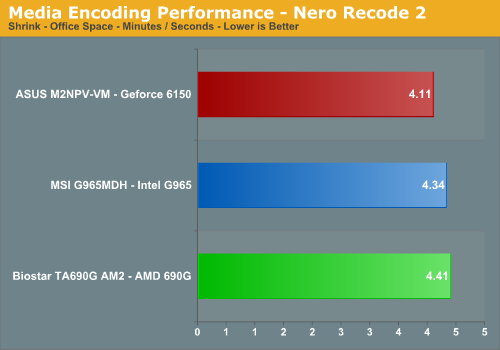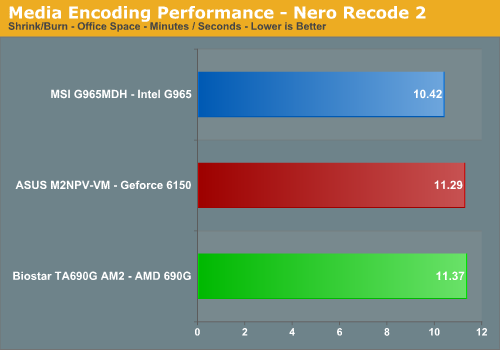Media Encoding Performance
A traditional weak spot of the current AM2 processor offerings has been in the media encoding arena when compared to the Intel Core 2 Duo. Considering the main optimizations for the Core 2 Duo centered on overall media encoding performance, we were very interested in seeing how this platform compared to current AMD lineups. We are utilizing an updated video encoding test suite for this article that includes AnyDVD, Nero Recode 2, Windows Media Encoder 9, and QuickTime Pro 7.1.
Our first series of tests is quite easy - we take our original Office Space DVD and use AnyDVD and Nero Recode 2 to copy the full DVD to the hard drive without compression, thus providing an almost exact duplicate of the DVD. We then fired up Nero Recode 2, selected our Office Space copy on the hard drive, and performed a shrink operation to allow the entire movie along with extras to fit on a single 4.5GB DVD disc. We then go back and use Nero Recode to shrink the full DVD copy and burn it onto our DVD disc. We left all options on their defaults except we checked off the advanced analysis option. The scores reported include the full encoding process and are represented in minutes/seconds, with lower numbers indicating better performance.



The results are very interesting as we did not expect our AM2 systems to perform this well and to do so is very surprising when reviewing other media encoding results. In fact, we ran the test several times and verified our settings before accepting the test results. Perhaps the last few months of Core 2 Duo results constantly exceeding AM2's best by a wide margin have tainted our cognitive abilities.
Of course, we are using a mid-range AM2 processor against the budget C2D part (the AMD price cuts have helped matters there, as the price difference is currently only about $35) but we fully believe the majority of the performance difference lies in the chipset selection on the AM2 systems. It is only in the shrink and burn tests that we see the Intel platform flexing its muscles. The difference in the shrink portion of this test was minimal and mirrored our individual shrink test results. We noticed our Intel platform was able to feed data to our DVD drive in a consistent manner with each of the AM2 platforms suffering from stutters several times resulting in our drive slowing down during the burn process. It was difficult to figure out if this was a driver, disk controller, or CPU issue. We are still testing on other chipset and CPU combinations.
Our next test has us converting our day at the beach AVI file into a high definition WMV file suitable for our Aunt Gertrude to view on her new high definition LCD TV. We ensured our quality settings were set for High Definition output. The remaining options are left at default values and then we let this program do its magic. We are reporting the numbers in minutes/seconds to complete the conversion.

These results left our heads shaking and we busily scurried off to the far corners of the lab looking for answers. After several test repeats, a few new images, and a couple of drinks, we stand by the results. Our answer, which we came up with after we switched out the MSI G965 board for a Gigabyte G965 board and had the same results, is that our E6300 is just incapable of keeping up with our AM2 5200+ X2 in this test. Why? It's all about the cache and CPU speed. Our E6600 trounces the 5200+ X2 at stock speeds and scores near it when running at E6300 speeds thanks to the increased cache. Meanwhile, our E6400 is just slightly off the 5200+ X2 pace at a modest 300MHz increase in speed over the E6300.
Next on the list is our QuickTime Pro 7.1 test that will convert our newly downloaded .Mov file into a plasma screen pleasing H.264 format. We ensured our quality settings were set to their highest levels and then let the horses loose. The values reported are again in minutes/seconds for the conversion time, with lower numbers being better.

Once again, the AM2 platforms have a slight advantage with the 6150 scoring outside of the norm in this test - so far outside that we thought something was not kosher in the land of NVIDIA. Fortunately for us, the answer was easy once we reviewed the playback files. It seems as though the quality of our encoding results on the NVIDIA platform left much to be desired along with numerous frames missing during playback or other frames just tangled together at times. We ran this same test under XP without an issue so our first blip with Vista has now occurred. Our video images are presented below.
In these particular screen shots both the G965 and 690G image quality results are basically even, but the 6150 is showing a case of the jaggies at full screen resolution. The entire playback file suffered from this issue.
A traditional weak spot of the current AM2 processor offerings has been in the media encoding arena when compared to the Intel Core 2 Duo. Considering the main optimizations for the Core 2 Duo centered on overall media encoding performance, we were very interested in seeing how this platform compared to current AMD lineups. We are utilizing an updated video encoding test suite for this article that includes AnyDVD, Nero Recode 2, Windows Media Encoder 9, and QuickTime Pro 7.1.
Our first series of tests is quite easy - we take our original Office Space DVD and use AnyDVD and Nero Recode 2 to copy the full DVD to the hard drive without compression, thus providing an almost exact duplicate of the DVD. We then fired up Nero Recode 2, selected our Office Space copy on the hard drive, and performed a shrink operation to allow the entire movie along with extras to fit on a single 4.5GB DVD disc. We then go back and use Nero Recode to shrink the full DVD copy and burn it onto our DVD disc. We left all options on their defaults except we checked off the advanced analysis option. The scores reported include the full encoding process and are represented in minutes/seconds, with lower numbers indicating better performance.



The results are very interesting as we did not expect our AM2 systems to perform this well and to do so is very surprising when reviewing other media encoding results. In fact, we ran the test several times and verified our settings before accepting the test results. Perhaps the last few months of Core 2 Duo results constantly exceeding AM2's best by a wide margin have tainted our cognitive abilities.
Of course, we are using a mid-range AM2 processor against the budget C2D part (the AMD price cuts have helped matters there, as the price difference is currently only about $35) but we fully believe the majority of the performance difference lies in the chipset selection on the AM2 systems. It is only in the shrink and burn tests that we see the Intel platform flexing its muscles. The difference in the shrink portion of this test was minimal and mirrored our individual shrink test results. We noticed our Intel platform was able to feed data to our DVD drive in a consistent manner with each of the AM2 platforms suffering from stutters several times resulting in our drive slowing down during the burn process. It was difficult to figure out if this was a driver, disk controller, or CPU issue. We are still testing on other chipset and CPU combinations.
Our next test has us converting our day at the beach AVI file into a high definition WMV file suitable for our Aunt Gertrude to view on her new high definition LCD TV. We ensured our quality settings were set for High Definition output. The remaining options are left at default values and then we let this program do its magic. We are reporting the numbers in minutes/seconds to complete the conversion.

These results left our heads shaking and we busily scurried off to the far corners of the lab looking for answers. After several test repeats, a few new images, and a couple of drinks, we stand by the results. Our answer, which we came up with after we switched out the MSI G965 board for a Gigabyte G965 board and had the same results, is that our E6300 is just incapable of keeping up with our AM2 5200+ X2 in this test. Why? It's all about the cache and CPU speed. Our E6600 trounces the 5200+ X2 at stock speeds and scores near it when running at E6300 speeds thanks to the increased cache. Meanwhile, our E6400 is just slightly off the 5200+ X2 pace at a modest 300MHz increase in speed over the E6300.
Next on the list is our QuickTime Pro 7.1 test that will convert our newly downloaded .Mov file into a plasma screen pleasing H.264 format. We ensured our quality settings were set to their highest levels and then let the horses loose. The values reported are again in minutes/seconds for the conversion time, with lower numbers being better.

Once again, the AM2 platforms have a slight advantage with the 6150 scoring outside of the norm in this test - so far outside that we thought something was not kosher in the land of NVIDIA. Fortunately for us, the answer was easy once we reviewed the playback files. It seems as though the quality of our encoding results on the NVIDIA platform left much to be desired along with numerous frames missing during playback or other frames just tangled together at times. We ran this same test under XP without an issue so our first blip with Vista has now occurred. Our video images are presented below.
 690G - Click to enlarge |
 G965 - Click to enlarge |
 6150 - Click to enlarge |
In these particular screen shots both the G965 and 690G image quality results are basically even, but the 6150 is showing a case of the jaggies at full screen resolution. The entire playback file suffered from this issue.










70 Comments
View All Comments
Gary Key - Wednesday, March 7, 2007 - link
The board will not do 1080P over the HDMI port at this time. 720P is working fine. The mATX will be up on the 19th, provided my heart is still working by that time, have to say that testing under Vista is not a pleasant experience. ;)dmce - Friday, March 9, 2007 - link
Gary, thanks for the info. Is the lack of ability to do 1080p related to Vista or will it just not do it at this stage. Is it likely bios/driver updates will improve this?chucky2 - Thursday, March 8, 2007 - link
Man, to me it sounds like - other than having video and audio in one cable - HDMI is not the way to go.Better to have DVI w/ HDCP it sounds like...plus, the connector is more beefcake, no falling out accidentally with DVI.
Chuck
Gary Key - Tuesday, March 6, 2007 - link
The platform will no do 1080P playback at this time in a consistent matter. As stated, we normally would end up with a slide show or a blank screen. AMD has told us 1080P will be possible with a driver update, proper playback support (PowerDVD or WinDVD), and a processor along the lines of a 5200+. We received a new driver update to address video quality issues we found late in testing but 1080P was not addressed yet. I am just as anxious as everyone else to see if it will do 1080P. ;)savantu - Tuesday, March 6, 2007 - link
This has to be one of the worst review ever done at Anandtech , almost makes you think somebody was paid to do it this bad.we fully believe the majority of the performance difference lies in the chipset selection.
Is this a joke or what ? The 2.6GHz 5200+ against a 1.86GHz Core 2 in media encoding and you think it is the chipset?! Every other test you made put the E6300 in between the 3800+ and 4200+.
goinginstyle - Tuesday, March 6, 2007 - link
Have you ever run a Conroe on a VIA or 945P chipset, if you have then you know what was meant by his statement.JarredWalton - Tuesday, March 6, 2007 - link
Try reading it in context:Nero Recode 2 performance:
AnyDVD Rip = 3-way tie more or less
Shrink = 6150 leads, G965 second, 690G last (despite 6150 and 690G using the same CPU)
Shrink/Burn = G965 first, 6150 and 690G virtually tied.
Full quote, instead of your selected text: "Of course, we are using a mid-range AM2 processor against the budget C2D part (the AMD price cuts have helped matters there, as the price difference is currently only about $35) but we fully believe the majority of the performance difference lies in the chipset selection. It is only in the shrink and burn tests that we see the Intel platform flexing its muscles...."
In other words, the difference we saw in the Shrink test indicates that the 6150 chipset is better for this task than 690G. We definitely know that the Core 2 Duo is faster at equivalent CPU prices than X2 chips, but we're looking at platforms and chipsets and not just CPUs.
UserNO - Tuesday, March 6, 2007 - link
Gawd, people, if you're going to tell us that we'll "have to play at 800x600" if we use these integrated graphics, why not test the games at 800x600 and report framerates? Find the highest (lowest) settings necessary to get a playable experience and tell us that. No one's going to run a game at 1024x768, get 15fps, and then give up; they're going to crank the settings and res down until they can play the game.It's not enough to just say "integrated graphics are unsuitable for even casual gamers, buy a discrete card" and then not quantify the difference.
Gary Key - Tuesday, March 6, 2007 - link
We tested the games at 800x600 and the results will be in our mATX roundup along with dedicated video scores.In the meantime-
800x600- HQ settings
690G 6150 G965
BF2 20.68 17.4 DNF
HL2 35.7 28.8 5.3
CoH 26.4 21.7 24.9
Calin - Wednesday, March 7, 2007 - link
I just wanted to say I'm looking forward to the mATX roundupNice article overall, thanks. And you might want to invest in some cheap Intel and AMD processors (the low-end, for $100 both), just to be able to compare them (I'm not suggesting complete testings on every processor possible)